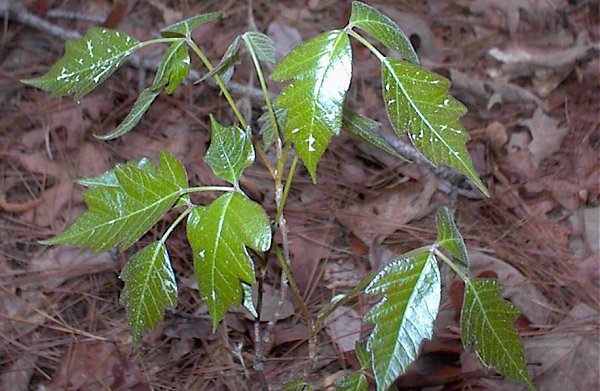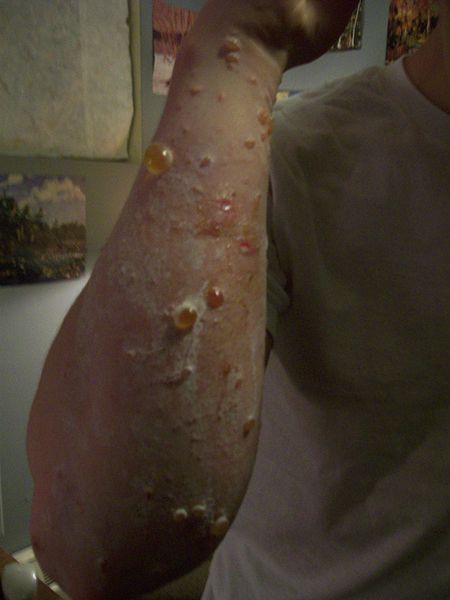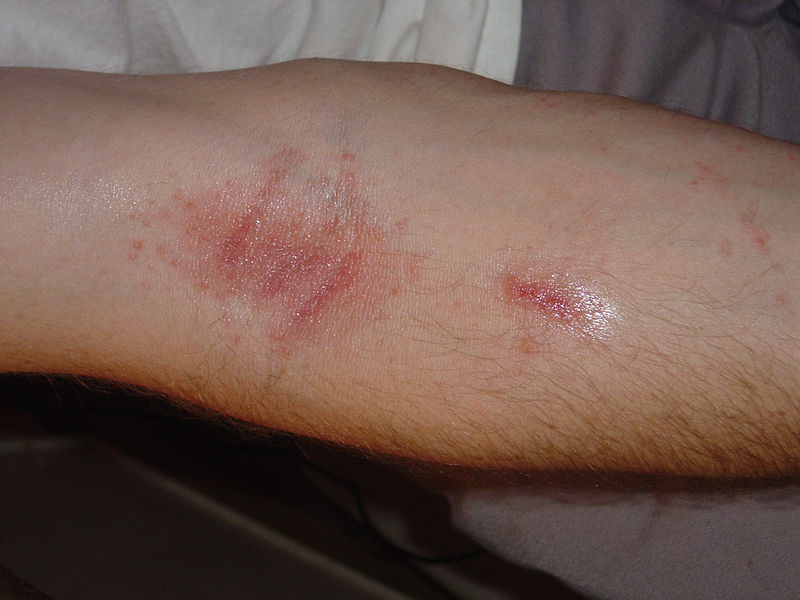Urushiol-induced contact dermatitis
| Urushiol-induced contact dermatitis | |
| ICD-10 | L23.7 |
|---|---|
| ICD-9 | 692.6 |
| DiseasesDB | 32755 |
| eMedicine | emerg/452 |
| MeSH | D011040 |
Overview

Urushiol-induced contact dermatitis (also called Toxicodendron dermatitis and Rhus dermatitis) is the medical name given to allergic rashes produced by oil urushiol, which is contained in various plants, including the plants of the genus Toxicodendron (including poison ivy, poison oak, and poison Sumac), as well as other plants in the family Anacardiaceae (mango, Rengas tree, Burmese lacquer tree, India marking nut tree, and the shell of the cashew nut), and even unrelated plants such as Ginkgo biloba.
Symptoms of the rash include itching, inflammation, oozing, and in severe cases a burning sensation. The American Academy of Dermatology estimates that there are up to 50 million cases of urushiol-induced dermatitis annually in the United States alone, accounting for 10% of all lost-time injuries in the United States Forest Service. Poison oak is a significant problem in the rural western and southern U.S., while poison-ivy is most rampant in the eastern U.S. Dermatitis from poison sumac is less common, but just as problematic.
Exposure

Urushiol-induced contact dermatitis is contracted by contact with a plant or any other object containing urushiol oil. Clothing or other materials that contact the plant and then, before being washed, contact the skin are common causes of exposure. Normally, it takes about 24 hours for the rash to first appear, though it may worsen during the next few days and may appear to spread, when in fact what is happening is that areas that received a lesser dose are reacting. The rash can take one to two weeks to run its course, and in some cases up to five weeks.
Urushiol is primarily found in the spaces between plant cells beneath the outer skin of the plant, so the effects of urushiol rash are less severe if the plant tissue remains undamaged on contact. Once the oil and resin are thoroughly washed from the skin, the rash is not contagious. Urushiol does not spread once it has bound with the skin, and it is not found in weeping blisters. Although the rash may worsen during the first few days and may appear to spread to new areas, this is usually simply latent reaction.
Although simple skin exposure is most common, ingestion can also lead to serious, more systemic reactions. Burning plant material is commonly said to create urushiol-laden smoke that causes systemic reaction as well as rash inside the throat and on the eyes. A high-temperature fully inflamed bonfire might incinerate the urushiol before it can cause harm, while a smoldering fire could vaporize the volatile oil and spread it as white smoke. However, some sources dispute the danger of burning urushiol-containing plant material.[1]
Aids to identification
The four characteristics are clusters of 3 leaflets(leaflet 3 let it be is the mnemonic used to describe the appearance), alternate leaf arrangements, lack of thorns, each group of 3 leaflets grows on its own stem, which connects to the main vine.[2]
Mechanism

The toxic effects of urushiol are largely indirect, mediated by an induced autoimmune response. Urushiol chemically reacts with, binds to and changes the shape of cell surface proteins on exposed skin cells. Affected proteins interfere with the immune systems ability to recognize these cells as normal parts of the body. These abnormally coated cells (perhaps confused by the immune system with invading parasites) are recognized as foreign, initiating a T-cell mediated immune response. This immune response is directed towards the complex of urushiol derivatives which are bound up in the skin proteins and attacks the cells as if they were a foreign agent. The result is an allergic eczematous contact dermatitis characterized by redness, swelling, papules, vesicles, blisters, and streaking. People vary greatly in their sensitivity to urushiol. In approximately 15%[3] to 30%[4] of people urishiol does not initiate an immune system response, while at least 25% of people have very strong immune responses resulting in severe symptoms. Since the skin reaction is an allergic one, people may develop an increasingly strong reactions after repeated exposures, or show no immune response on their first exposure, but show sensitivity on following exposures.
The rash takes one to two weeks to run its course, but normally does not leave scars. Severe cases will have small (1–2 mm) clear fluid-filled blisters on the skin. Pus-filled vesicles, containing a whitish fluid, may indicate a secondary infection. Most poison ivy rashes, without infections, will self-resolve within 14 days without treatment. Excessive scratching may result in secondary infection, commonly by staphylococcal and streptococcal species. These may require the use of antibiotics.
Treatments
Primary treatment involves washing exposed skin thoroughly with soap and water as soon as possible after exposure is discovered. Soap or detergent is necessary, as urushiol is a hydrophobic (oily) substance and is not washed off by plain water. Once an outbreak has occurred topical application of cold compresses, Burow's solution, calamine lotion, antihistamines, aloe vera and hydrocortisone ointment are common home-remedies used to abate the symptoms. Oral adminsitration of aspirin and antihistamines may provide some relief from the itch and irritation.
No vaccine has been developed to counter urushiol symptoms, so the most effective "cures" are generally held to be those products that physically remove the urushiol. After about 15 minutes of exposure, the urushiol is chemically bonded to the skin and can only be removed with pharmaceutical products, which vary by person in effectiveness. Two of these products, which are both over the counter drugs in the United States, are:
- Tecnu: Originally developed early in the Cold War as a treatment for radiation exposure, it was discovered later that Tecnu provided some relief for poison ivy exposure. It is a milky liquid and the main active ingredient is octylphenoxy-polyethoxyethanol. The four octyl groups of this chemical are too large to surround the non-polar molecules in the urushiol, which remains partially active and requires multiple applications. Also, the chemical makeup of the product requires that it be applied no later than eight hours after exposure to urushiol.
- Zanfel: Developed in 1999, this paste uses an ethoxylate molecule with the large octyl groups removed. This allows the molecule to "wrap" around the non-polar molecules of the urushiol and inactivate it. The other ingredient, sodium lauryl sarcosinate, allows the ethoxylate to form a micelle around the urushiol molecule. This creates a large molecule that contains flexible non-polar groups and soluble polar groups, allowing it to be rinsed away with water. In rigorous company-funded studies, it appears to be effective, even in cases of advanced rash.[3] Unlike Tecnu, Zanfel is effective even many days after exposure, removing the urushiol, stopping the itching, and beginning healing of the rash after only a small number of applications. It is a fairly expensive product, about $40US for a small bottle (2007 price), but cost-effective due to the degree of suffering it alleviates, in proportion to its cost. A small bottle provides many applications, so the cost per dose is relatively low.
- Tecnu Extreme: Developed in 2005, this is also a paste with surfactants and micro-fine scrubbing particles to break the bond the urushiol has with the proteins in the skin, so the urushiol can be rinsed away with water. The product contains an active ingredient, grindelia robusta, for itch relief. It is most helpful if a rash has already started, but it can also be used to remove urushiol after exposure--before the rash has broken out.
In cases of extreme symptoms, steroids such as Prednisone are sometimes administered to attenuate the immune response. If bacterial secondary infection of affected areas occurs, antibiotics may also be necessary.
There are many myths that deal with treating toxicodendrons such as poison ivy. Most have been discredited, but persist despite their falsehood. Some clarifications (these statements are true):
- Scrubbing with plain soap and water will remove the urushiol from skin if it is done within a few minutes of exposure, before it bonds.
- Ordinary laundering with laundry detergent will remove urushiol from most clothing, but not leather or suede.
- The fluid from the resulting blisters does not spread poison ivy to others.
- Poison ivy is not harmless when the leaves have fallen off as the toxic resin is very persistent. Every part of the plant contains urushiol, and can cause a rash with exposure at any time of the year.
- Burning any part of the poison ivy, poison oak or poison sumac plants can produce a fatal systemic reaction in any person who comes in contact with the smoke, even a mile or more away in certain conditions.
- Ice, water, soap, lotions, dry cold air, do not help cure poison ivy rashes, they only sooth the itch.
- Urinating on the affected areas has no effect.
See also
References
- ↑ Dietrich Frohne and Hans Jurgen Pfander (1984). A Colour Atlas of Poisonous Plants: A Handbook for Pharmacists, Doctors, Toxicologists, and Biologists. Wolfe Publishing Ltd. pp. 291 pp. ISBN 0-7234-0839-4.
- ↑ wikipedia from [1]
- ↑ Ginsburg, Erika. "Itching for Relief". Washington Post. August 31, 2004. [2]
External links
- Poison Ivy: Prevention and Treatment
- Poison Ivy Myths
- Poison Oak at Wayne's Word